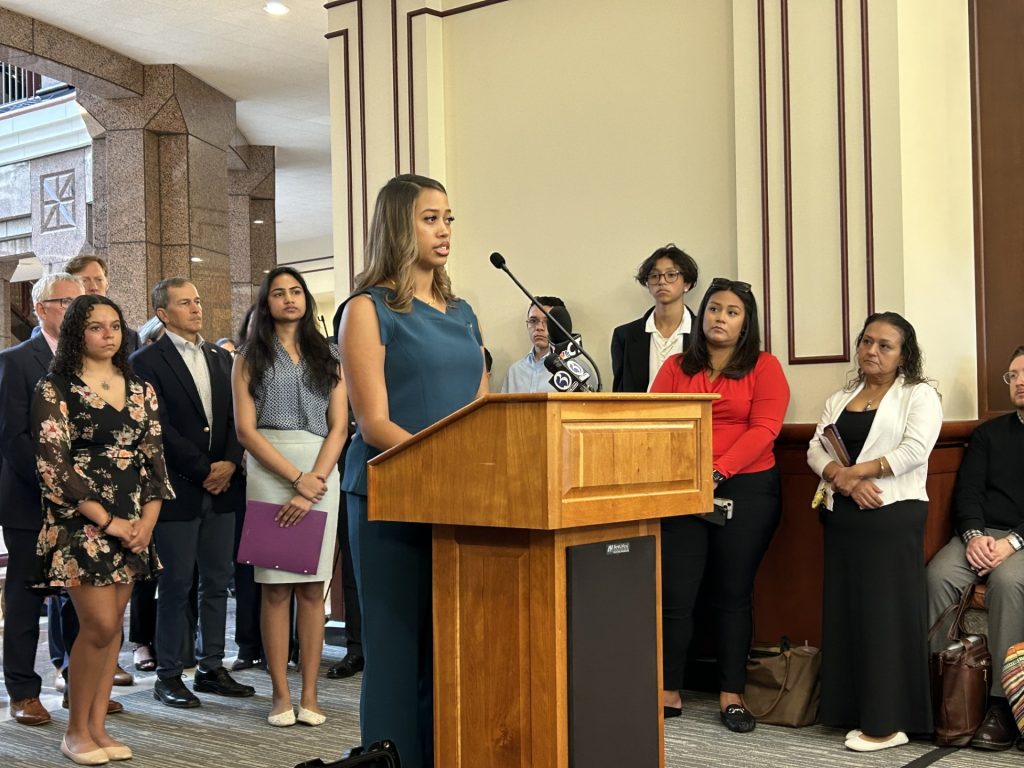The Connecticut Conference of Municipalities released a report earlier this month that targets the expansion of youth support services at the local and state levels — at an estimated cost of $900 million.
The report was a product of the 119K Commission, a 15-person group made up mainly of town mayors tasked with coming up with strategies to tackle the problem of how to help Connecticut’s 119,000 “disconnected youth.”
Here’s what to know about the report.
What led to the report’s creation?
Around this time last year, Dalio Education, a grant foundation that engages with public school communities and provides funding to several nonprofits, released its own report that said more than 119,000, or about 19%, of young people in Connecticut between the ages of 14 and 26 were “at risk” or “disconnected” in 2021-22.
That document defined “at risk” as high schoolers who had a low number of credits and were not on track to graduate on time and students struggling with other factors including chronic absenteeism or behavioral issues. “Disconnected” was defined as high school graduates who were neither employed nor enrolled in higher education, high school non-graduates who were employed, young adults who had neither a high school diploma nor employment, and incarcerated individuals in that age group.
Months later, the 119K Commission was created and tasked with producing “a comprehensive, bipartisan, pragmatic strategy” to address issues certain to require local, state and private sector actions.
Their new strategy report was released this month and lands as the state legislative campaign season is winding down and Gov. Ned Lamont’s administration and lawmakers will soon begin to confront the myriad possibilities and challenges in crafting the next biennial budget in the legislative session that starts in January.
What is the report proposing?
The commission said its “North Star” goal is to get 60,000 at-risk and disconnected youth back on track within the next 10 years.
Their proposed decadelong strategy calls for increasing investment, accountability and transparency in broad swaths of government, including K-12 education, job training and mental health.
The report outlined four “strategic pillars:” coordinating supports for youth at all levels of the system; creating stronger conditions for youth success within and beyond school; increasing capacity in the system; and building and sustaining coalitions.
Within those pillars are proposals like revamping Connecticut’s 2-1-1 system with the development of a new app to help youth access resources, further support of policies to implement a federal child tax credit, the creation of an outcomes-based Connecticut Career Accelerator Program which would support student pathway programs, the launch of a statewide Youth Service Corps and more.
How was the report created?
The report was created using feedback from roundtables of 200 youth from Waterbury, Stamford, Bridgeport, Stratford and Hartford, that represented a “mix of young people from at risk, to modernly disconnected, to severely disconnected, different ages, genders and race,” and their perspectives, commission members said in August.
Students told the commission that youth programs and resources are hard to navigate and that high school can feel like an obstacle when they can’t find transportation to campus, may have to take care of siblings or curriculum may not fit their interests.
How much will it cost?
By calculating the estimated cost of inaction at $750 million, it helps make an economic case for phasing in more than $900 million in additional spending: $545 million on education aid and $408 million on social services, the Connecticut Conference of Municipalities said.
Behavioral counseling, career planning and workforce development, homelessness prevention, recreation and other services all would be prioritized.
The initial cost to begin the expansions would be closer to $150 million.
How will it be funded?
The report says Connecticut can pay for annual costs associated with its proposal through three major sources: reinvesting fiscal impact of strategy ($650 million to $750 million), which would include incremental tax revenue and reduced spending on government and social services; reallocation of spending ($500 million to $900 million), which would include increased efficiency and consolidation, phasing out ineffective programs and reprioritization; and new or expanded revenue sources ($300 million to $2 billion) through spending cap carve-outs, investment, philanthropy, federal funding and new taxes.
The report said the State Bond Commission “should expand access to General Obligation bond-backed funds to programs supporting young people,” and should “consider the creation of new bond programs to pay for key investments.”
The report also proposes that the state “could raise funds from investors tied to youth reconnection outcomes.”
Other funding proposals include “exploring exempting education expenditures from the spending cap,” leaning on philanthropic donations with an offer of tax credit or exploring a “variety of new taxes, including taxes on income, wealth, property or ‘sin taxes’.”
Asked about the hefty price tag, Lamont told The Connecticut Mirror last week that he wants to start with improving and reallocating resources in “what we’re already doing.”
“Don’t assume every single report we got to start from scratch and that everything is new and incremental — that’s a sort of a tendency we have in government,” Lamont said. “I’m not one of those that’s always convinced that more money is the issue, we’ve made the biggest commitment to K-12 education in the history of the state, but also, how do you make it better? That’s why I come to groups like this to see what they think is working. … Tell us if what we’re doing, we can do better. Tell us what you think is not working. Maybe I reallocate those resources to expanding programs like this.”
Editor’s Note: The CT Mirror receives funding from the Dalio Education foundation.
Related Stories:
Former ‘at-risk youth’ talk resources as CT weighs investments
CCM opens effort to save at-risk youth, overhaul CT government
Report: About 19% of CT youth ‘disconnected’ or ‘at risk’ in 2021-22

